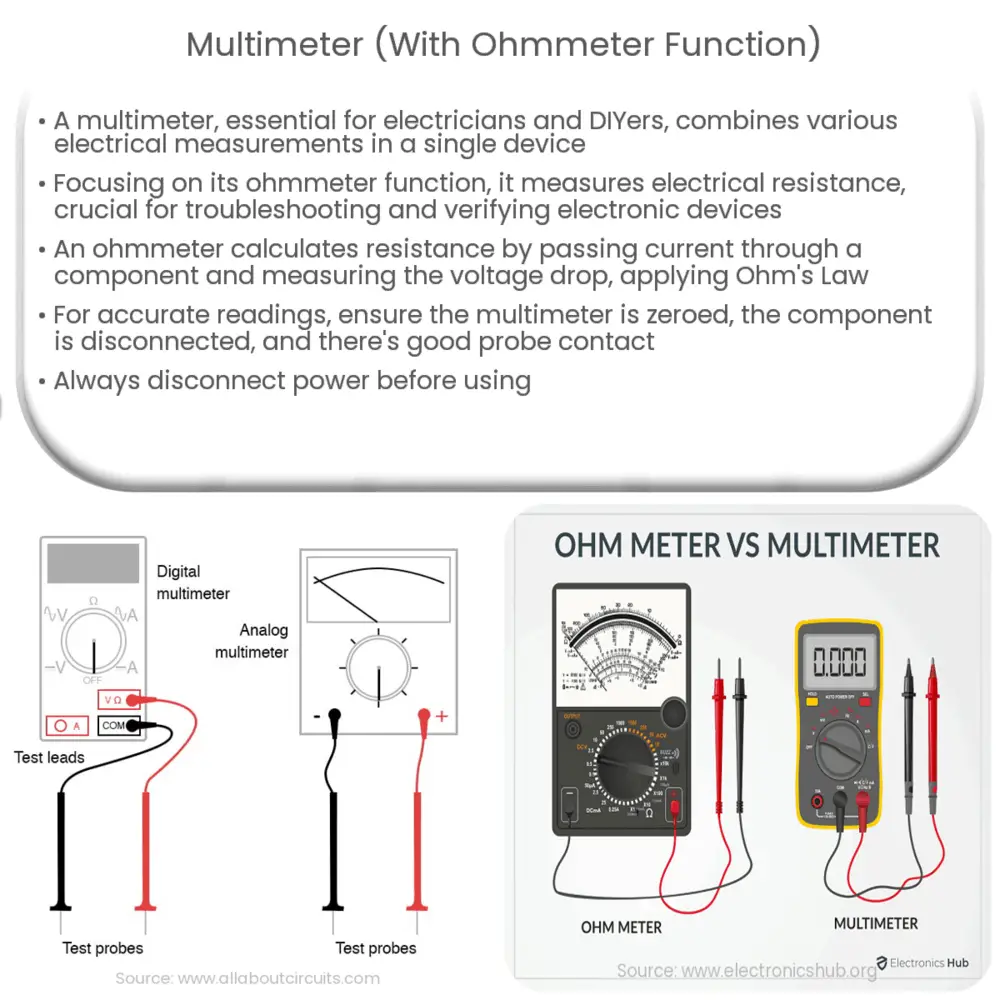A multimeter’s ohmmeter function measures electrical resistance, helping diagnose faulty components, open circuits, and short circuits in electronic devices.

Multimeter: A Comprehensive Guide on the Ohmmeter Function
A multimeter is a versatile and essential tool for electricians, technicians, and DIY enthusiasts alike. It combines multiple electrical measurement functions in one portable, handheld device. In this article, we’ll focus on the ohmmeter function of a multimeter, which is used to measure electrical resistance. This measurement is crucial for troubleshooting circuits and ensuring the proper functioning of electronic devices.
What is an Ohmmeter?
An ohmmeter is an instrument that measures the electrical resistance (in ohms) of a component or circuit. It works by passing a small current through the component and then measuring the voltage drop across it. By using Ohm’s Law (Voltage = Current x Resistance), the resistance value can be calculated.
How Does the Ohmmeter Function Work on a Multimeter?
The ohmmeter function is integrated into most multimeters, making it convenient for users to measure resistance without needing a separate device. To use the ohmmeter function on a multimeter, follow these steps:
- Power off the circuit or device being tested.
- Set the multimeter’s dial to the ohmmeter (Ω) function. You may also need to select the appropriate range if your multimeter isn’t auto-ranging.
- Insert the test probes into the appropriate sockets on the multimeter. The black probe typically goes into the COM socket, while the red probe goes into the VΩmA socket.
- Touch the test probes to the component or circuit you want to measure. For accurate results, ensure good contact between the probes and the component’s terminals.
- Read the resistance value displayed on the multimeter’s screen.
It’s important to note that the ohmmeter function should not be used on live circuits. Always disconnect the power before taking resistance measurements.
Types of Resistance Measurements
There are various types of resistance measurements that you can perform with a multimeter, including:
- Continuity: A continuity test checks if there’s an electrical connection between two points in a circuit. A low resistance value indicates a continuous connection, while a high resistance or no reading suggests a break in the connection.
- Insulation: Insulation resistance tests evaluate the effectiveness of an insulator, such as wire insulation or a circuit board’s substrate. A high resistance value indicates proper insulation, while a low resistance value suggests a potential short circuit risk.
- Component testing: The ohmmeter function can be used to test individual components, such as resistors, inductors, and capacitors, to ensure they’re functioning within their specified parameters.
Using Ohmmeter Function to Troubleshoot Common Electrical Issues
The ohmmeter function on a multimeter can help diagnose and troubleshoot a variety of electrical issues, such as:
- Open circuits: By measuring the resistance between two points in a circuit, you can identify open circuits or breaks in the wiring, which result in high resistance or no reading at all.
- Short circuits: A short circuit occurs when there’s an unintended connection between two points in a circuit, causing low resistance. The ohmmeter function can be used to detect short circuits by identifying areas with unexpectedly low resistance values.
- Faulty components: If a component isn’t functioning correctly, it may cause abnormal resistance values. Using the ohmmeter function, you can test components individually to identify any faulty parts that need replacement.
Tips for Accurate Resistance Measurements
To ensure accurate and reliable resistance measurements using a multimeter’s ohmmeter function, follow these tips:
- Zero the multimeter: Before taking a measurement, touch the test probes together and make sure the multimeter reads zero ohms or close to it. This step compensates for any resistance in the test leads.
- Disconnect the component: When measuring the resistance of a component, it’s best to disconnect it from the circuit to prevent interference from other components and to avoid parallel or series resistance affecting the readings.
- Use proper contact: Ensure the test probes make good contact with the component or circuit points being tested. Poor contact can lead to inaccurate measurements.
- Battery condition: A weak or depleted battery in the multimeter can cause inaccurate readings. Replace the battery if necessary.
Conclusion
The ohmmeter function of a multimeter is an indispensable tool for anyone working with electrical circuits and components. By understanding how to use this function effectively, you can troubleshoot common electrical issues, diagnose faulty components, and ensure the proper functioning of electronic devices. Keep in mind the tips for accurate measurements and always practice safety by disconnecting power before using the ohmmeter function.

